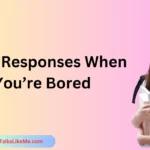When someone asks why you’re sad, it can sometimes feel like a probing question rather than a genuine concern. Adding a touch of humor can lighten the mood and shift the focus from your sadness to a more positive interaction. Drawing from personal experiences and a bit of wit, here are some funny and creative responses that might just bring a smile to your face and theirs.
1. “I’m just practicing for my role in the next drama series.”
Using humor to deflect and lighten the mood, this response adds a playful twist to your situation. I’ve used this when I wanted to acknowledge my mood without going into details.
When to use: When you want to keep the conversation light and humorous.
When not to use: If the person is genuinely concerned and looking for a serious answer.
Example:
“I’m just practicing for my role in the next drama series.”
2. “I’m auditioning for the role of a professional sad person. How’s my performance?”
Turning your sadness into a joke about a role can make the situation less heavy. I’ve used this when I wanted to add humor to a conversation.
When to use: When you want to make light of the situation.
When not to use: If you need to discuss your feelings seriously.
Example:
“I’m auditioning for the role of a professional sad person. How’s my performance?”
3. “I’m saving my tears for the grand finale of my soap opera.”
Using a melodramatic comparison can bring a smile and lighten the mood. I’ve used this to make light of my situation and shift the conversation.
When to use: When you want to make a dramatic but humorous statement.
When not to use: If the other person is looking for a more sincere conversation.
Example:
“I’m saving my tears for the grand finale of my soap opera.”
4. “I’m practicing for a new career as a sad clown. I think I’m getting the hang of it!”
Adding a humorous twist about a new career can make your sadness seem less serious. I’ve used this when I wanted to inject humor into the conversation.
When to use: When you want to keep things light and funny.
When not to use: If the person is seeking a genuine explanation.
Example:
“I’m practicing for a new career as a sad clown. I think I’m getting the hang of it!”
5. “I’m just here for the audition of the next big tear-jerker movie!”
Turning your sadness into a movie audition joke can make the situation more light-hearted. I’ve used this to add a bit of humor.
When to use: When you want to use humor to deflect the question.
When not to use: If the person is trying to offer real support.
Example:
“I’m just here for the audition of the next big tear-jerker movie!”
6. “My puppy ate my homework, and now my life is in shambles.”
Using an exaggerated excuse can make your response humorous. I’ve used this to keep the mood light and avoid discussing deeper issues.
When to use: When you want to make a light-hearted joke.
When not to use: If you’re looking for understanding or empathy.
Example:
“My puppy ate my homework, and now my life is in shambles.”
7. “I’m practicing my sad face for the next big selfie. What do you think?”
Making a joke about a selfie can turn the conversation into something amusing. I’ve used this when I wanted to add humor to the situation.
When to use: When you want to deflect with humor.
When not to use: If the person is trying to provide support.
Example:
“I’m practicing my sad face for the next big selfie. What do you think?”
8. “I’m just trying to win the award for ‘Best Sad Face in a Casual Setting.’”
Making light of your sadness with a fictional award can be funny and engaging. I’ve used this to make the situation less serious.
When to use: When you want to joke about your mood.
When not to use: If the other person is concerned about your well-being.
Example:
“I’m just trying to win the award for ‘Best Sad Face in a Casual Setting.’”
9. “I’m currently perfecting my ‘sad puppy’ look for a photo contest.”
Using a humorous comparison to a sad puppy can make your response playful. I’ve used this to add a bit of humor to my sadness.
When to use: When you want to keep things light-hearted.
When not to use: If the person is looking for a more serious answer.
Example:
“I’m currently perfecting my ‘sad puppy’ look for a photo contest.”
10. “I’m just gearing up for my role as the lead in ‘The Sad Chronicles.’”
Making a joke about a dramatic role can turn your sadness into a playful topic. I’ve used this to deflect while keeping the conversation light.
When to use: When you want to joke about your mood.
When not to use: If the person is looking to provide support or comfort.
Example:
“I’m just gearing up for my role as the lead in ‘The Sad Chronicles.’”
11. “I’m auditioning for a part in a new sad-themed reality show. How am I doing?”
Turning your sadness into a reality show audition can be humorous. I’ve used this to add levity to the situation.
When to use: When you want to use humor to deflect the question.
When not to use: If you’re seeking a more sincere conversation.
Example:
“I’m auditioning for a part in a new sad-themed reality show. How am I doing?”
12. “I’m just here to break the record for the longest sad face ever.”
Making a joke about breaking a record can be funny and engaging. I’ve used this when I wanted to keep things light-hearted.
When to use: When you want to joke about your mood.
When not to use: If you’re looking for genuine support.
Example:
“I’m just here to break the record for the longest sad face ever.”
13. “I’m in training for the next big emotional rollercoaster ride!”
Turning your sadness into a metaphor for a rollercoaster can add humor. I’ve used this to keep the mood light.
When to use: When you want to make a humorous comparison.
When not to use: If the person is concerned and looking for a serious conversation.
Example:
“I’m in training for the next big emotional rollercoaster ride!”
14. “I’m just practicing for my new role as the world’s saddest emoji.”
Using a funny comparison to an emoji can make your response playful. I’ve used this to add humor to my sadness.
When to use: When you want to keep the conversation light.
When not to use: If the person is seeking a deeper explanation.
Example:
“I’m just practicing for my new role as the world’s saddest emoji.”
15. “I’m currently perfecting my ‘sad but still fabulous’ look.”
Combining sadness with a touch of humor about being fabulous can be funny. I’ve used this to deflect with a playful attitude.
When to use: When you want to joke about your appearance.
When not to use: If you’re looking for empathy or understanding.
Example:
“I’m currently perfecting my ‘sad but still fabulous’ look.”
16. “I’m just in training for the next big emotional movie scene.”
Using a movie scene comparison can make your response humorous. I’ve used this to add levity to the situation.
When to use: When you want to keep the mood light and funny.
When not to use: If the person is trying to offer support.
Example:
“I’m just in training for the next big emotional movie scene.”
17. “I’m perfecting my sad face for the annual ‘Misery Awards.’”
Adding a humorous touch with an imaginary award can lighten the mood. I’ve used this to deflect with humor.
When to use: When you want to use humor to change the topic.
When not to use: If you’re looking for a more sincere conversation.
Example:
“I’m perfecting my sad face for the annual ‘Misery Awards.’”
18. “I’m just preparing for my audition as the lead in ‘The Saddest Movie Ever.’”
Making a joke about an audition can add humor to your response. I’ve used this to keep the conversation light-hearted.
When to use: When you want to joke about your mood.
When not to use: If the person is seeking a deeper explanation.
Example:
“I’m just preparing for my audition as the lead in ‘The Saddest Movie Ever.’”
19. “I’m trying out for the role of the saddest person in the world. How am I doing?”
Turning your sadness into a role-play joke can be engaging. I’ve used this when I wanted to keep things playful.
When to use: When you want to add humor to your situation.
When not to use: If the other person is concerned about your well-being.
Example:
“I’m trying out for the role of the saddest person in the world. How am I doing?”
20. “I’m just perfecting my ‘sad face’ for the next big photo op.”
Using a humorous take on preparing for a photo can be funny. I’ve used this to deflect with a light-hearted approach.
When to use: When you want to keep things humorous.
When not to use: If the person is looking to offer support.
Example:
“I’m just perfecting my ‘sad face’ for the next big photo op.”
21. “I’m in the middle of a deep emotional training for my next big role.”
Turning sadness into a training metaphor can be amusing. I’ve used this when I wanted to joke about my situation.
When to use: When you want to add humor.
When not to use: If the person is offering real support.
Example:
“I’m in the middle of a deep emotional training for my next big role.”
22. “I’m practicing for my performance in ‘The Saddest Face Challenge.’”
Using a challenge metaphor can make your response funny and engaging. I’ve used this to lighten the mood.
When to use: When you want to joke about your mood.
When not to use: If the person is seeking a serious conversation.
Example:
“I’m practicing for my performance in ‘The Saddest Face Challenge.’”
23. “I’m in a competition for the best sad face. How’s my form?”
Turning sadness into a competition can be humorous. I’ve used this to add a playful twist.
When to use: When you want to use humor to lighten the conversation.
When not to use: If you need to discuss your feelings seriously.
Example:
“I’m in a competition for the best sad face. How’s my form?”
24. “I’m currently filming for ‘Sadness: The Documentary.’”
Using a documentary joke can make the situation seem less serious. I’ve used this to keep things light.
When to use: When you want to joke about your mood.
When not to use: If the person is concerned and needs a real answer.
Example:
“I’m currently filming for ‘Sadness: The Documentary.’”
25. “I’m just giving my tears a workout before the big event.”
Adding a humorous take on tears working out can be funny. I’ve used this to keep the conversation light-hearted.
When to use: When you want to joke about your mood.
When not to use: If you’re looking for support or understanding.
Example:
“I’m just giving my tears a workout before the big event.”
26. “I’m rehearsing for my role in ‘The Drama Queen Chronicles.’”
Turning sadness into a role-play joke can make the situation more humorous. I’ve used this when I wanted to deflect with humor.
When to use: When you want to use humor to lighten the mood.
When not to use: If the person is seeking a serious discussion.
Example:
“I’m rehearsing for my role in ‘The Drama Queen Chronicles.’”
27. “I’m perfecting my sad face for the ‘Emotional Expression Olympics.’”
Adding a competitive twist to your sadness can be funny. I’ve used this to keep things playful.
When to use: When you want to make light of your situation.
When not to use: If you’re looking for a more empathetic response.
Example:
“I’m perfecting my sad face for the ‘Emotional Expression Olympics.’”
28. “I’m in training for the ‘World Sadness Championship.’”
Using a championship metaphor can make your response engaging. I’ve used this to deflect with a humorous touch.
When to use: When you want to joke about your mood.
When not to use: If the person is concerned and needs a real answer.
Example:
“I’m in training for the ‘World Sadness Championship.’”
29. “I’m just working on my ‘sad but still fabulous’ look.”
Combining sadness with humor about being fabulous can be funny. I’ve used this to lighten the mood.
When to use: When you want to joke about your appearance.
When not to use: If you need to discuss your feelings seriously.
Example:
“I’m just working on my ‘sad but still fabulous’ look.”
30. “I’m currently the star of ‘The Sad Chronicles.’ It’s a big role!”
Turning sadness into a starring role can be humorous. I’ve used this to add levity to the conversation.
When to use: When you want to keep things light-hearted.
When not to use: If the person is seeking a deeper explanation.
Example:
“I’m currently the star of ‘The Sad Chronicles.’ It’s a big role!”
Top 10 Editor’s Choice Responses
- “I’m just practicing for my role in the next drama series.”
Ideal for a playful twist. - “I’m auditioning for the role of a professional sad person. How’s my performance?”
Great for a humorous deflection. - “I’m saving my tears for the grand finale of my soap opera.”
Perfect for a melodramatic joke. - “I’m just here for the audition of the next big tear-jerker movie!”
Adds a film-related humor. - “My puppy ate my homework, and now my life is in shambles.”
Uses an exaggerated excuse. - “I’m practicing my sad face for the next big selfie. What do you think?”
Combines humor with a selfie reference. - “I’m just trying to win the award for ‘Best Sad Face in a Casual Setting.’”
Makes sadness a humorous competition. - “I’m in training for the next big emotional rollercoaster ride!”
Uses a rollercoaster metaphor. - “I’m perfecting my sad face for the annual ‘Misery Awards.’”
Jokes about an imaginary award. - “I’m just preparing for my audition as the lead in ‘The Saddest Movie Ever.’”
Adds a dramatic touch.



